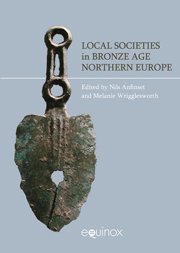Book contents
- Frontmatter
- Contents
- List of figures and tables
- Contributors
- Acknowledgements
- Introduction: local societies, regions and processes of cultural interaction in the Bronze Age
- PART I IDENTITY, GRAND NARRATIVES AND NETWORKS
- PART II REGIONS, GLOBALIZATION AND RESISTANCE
- 7 Northwestern Russia at the periphery of the north European and Volga-Uralic Bronze Age
- 8 Local centres in the periphery: the Late Neolithic, Bronze Age and Early Metal Age in Finland
- 9 The Nordic Bronze Age and the Lüneburg culture: two different responses to social change
- 10 Pottery, transmission and innovation in Mälardalen
- 11 Social landscapes of Bronze Age Scandinavia
- 12 The origin of a Bronze Age in Norway: structure, regional process and localized history
- 13 Social response or resistance to the introduction of metal? Western Norway at the edge of the “globalized” world
- Index
8 - Local centres in the periphery: the Late Neolithic, Bronze Age and Early Metal Age in Finland
from PART II - REGIONS, GLOBALIZATION AND RESISTANCE
- Frontmatter
- Contents
- List of figures and tables
- Contributors
- Acknowledgements
- Introduction: local societies, regions and processes of cultural interaction in the Bronze Age
- PART I IDENTITY, GRAND NARRATIVES AND NETWORKS
- PART II REGIONS, GLOBALIZATION AND RESISTANCE
- 7 Northwestern Russia at the periphery of the north European and Volga-Uralic Bronze Age
- 8 Local centres in the periphery: the Late Neolithic, Bronze Age and Early Metal Age in Finland
- 9 The Nordic Bronze Age and the Lüneburg culture: two different responses to social change
- 10 Pottery, transmission and innovation in Mälardalen
- 11 Social landscapes of Bronze Age Scandinavia
- 12 The origin of a Bronze Age in Norway: structure, regional process and localized history
- 13 Social response or resistance to the introduction of metal? Western Norway at the edge of the “globalized” world
- Index
Summary
The hypothesis: active periphery with peripheral centres
The purpose of this chapter is to indicate diversity in an area which in a large-scale perspective is usually placed at the margins of the Scandinavian Bronze Age. My hypothesis is, however, that the current territory of Finland and the Karelian Isthmus were not a homogeneous far-away periphery.
I will compare a few key phenomena on the coast and inland in Finland. Northern Lapland will not be included here because the region differs considerably from the southern part of the Nordic Bronze Age. Comparison between south and north Lapland would naturally be extremely interesting; in this chapter, however, these regions have been left for future discussions.
My first statement is that the end of Neolithic in the coastal and inland regions of the research area is problematic to date because of different phenomena that indicate a cultural change. The earliest cultivation is traceable in the Late Neolithic around 2300 BCE at the coast and 2200 BCE inland. Accordingly, although the spread of bronze axes began almost synchronously from two directions – southwest and east – it still seems clear that the earliest metal finds are known in the inland, not near the coast (Meinander 1954b; Lavento 2001). The possible reasons for this will be discussed later.
Second, on the basis of finds or bronze working, two local Bronze Age centres are traditionally distinguished. Figure 8.1 shows the coastal zone of southwest Finland; the large area in the east and north represents inland.
- Type
- Chapter
- Information
- Local Societies in Bronze Age Northern Europe , pp. 148 - 168Publisher: Acumen PublishingPrint publication year: 2012

